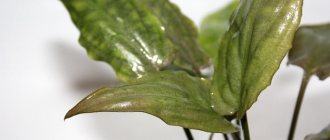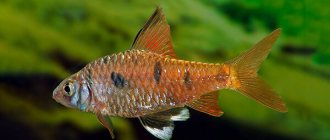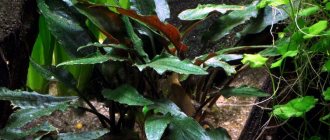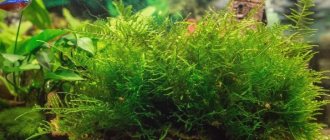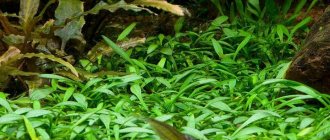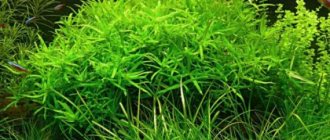Description
There are several types of cryptocorynes. Aponohethenofolia is the most striking representative of this genus. On a straight stem there are narrow, long leaves with a pointed tip and a clearly defined central vein.
The surface of the sheet is relief corrugated, rough, green. At the same time, its upper part is darker, and its lower part is lighter. The width of the leaf blade does not exceed 4 cm, but the length can be 50–70 cm, and in the natural environment – up to 1 meter. The red-brown petioles make up about half the length of the leaf.
The flower of this plant looks quite unusual. During the flowering period, Cryptocoryne aponoghetonolifolia throws out a tube 7 to 17 cm long with a narrow pointed plate of purple color. One plant can produce 6–8 female flowers and up to 70 male flowers. True, in captivity this happens rarely.
Description
There are several types of cryptocorynes. Aponohethenofolia is the most striking representative of this genus. On a straight stem there are narrow, long leaves with a pointed tip and a clearly defined central vein.
The surface of the sheet is relief corrugated, rough, green. At the same time, its upper part is darker, and its lower part is lighter. The width of the leaf blade does not exceed 4 cm, but the length can be 50–70 cm, and in the natural environment – up to 1 meter. The red-brown petioles make up about half the length of the leaf.
The flower of this plant looks quite unusual. During the flowering period, Cryptocoryne aponoghetonolifolia throws out a tube 7 to 17 cm long with a narrow pointed plate of purple color. One plant can produce 6–8 female flowers and up to 70 male flowers. True, in captivity this happens rarely.
Uses of Cryptocoryne
When decorating an aquarium with cryptocorynes, you can get a number of benefits. Very often, cryptocoryne is called a plant for the “lazy”. This is due to the fact that they love "old", established aquariums, therefore, they are one of the few plants that can thrive with infrequent water changes. This also includes the predominantly root consumption of nutrients by cryptocorynes. Root feeding allows for less frequent use of liquid fertilizers, which in turn reduces the likelihood of algae development.
Cryptocoryne aponoghetonolifolia is used to decorate the background of an aquarium.
Cryptocorynes are some of the most beautiful plants with many variations in color, shape and leaf size. This provides additional opportunities for the designer
Cryptocorynes are often used as a tapeworm - a design element, which is a single plant that compels attention and attracts the eye. Another design solution for which Cryptocoryne is often used is the creation of a “street”
At the same time, by selecting different species, you can create a smooth transition from green to red, as well as by the degree of increase in plant size.
Almost all types of cryptocorynes are suitable for foreground decoration, except for large long-leaved species. The slow growth of plants allows the composition to remain unchanged for a long time.
For the background, large species of cryptocorynes (for example, aponoghetonolifolia) are best suited. When planted tightly, plants can completely replace the decorative background and look very impressive.
Habitat
The homeland of this plant is the Philippines, where in the waters of fast-flowing rivers it grows at a depth of up to two meters, preferring shaded areas. In such places, entire thickets of cryptocoryne form. It is also found in well-lit areas. The plant is also widespread in the water bodies of Sri Lanka, Southeast Asia and Hindustan.
Species of Cryptocoryne Wendt
Cryptocoryne has many varieties, varying in leaf size, shape and color. About 10 species of this plant are especially often used to fill an aquarium.
Mi oya
Cryptocoryne wendtii Mi oya has many adherents among aquarists because of its beautiful appearance and unpretentious living conditions. In the natural environment it can be found only in one place - on the island of Sri Lanka in the Mi Oya River.
Cryptocoryne of this species is suitable for large aquariums, as it grows up to 30-35 cm. It is characterized by wide and long leaves of a red-brown color with a visible pattern in the center. The plant easily tolerates lack of lighting and high water temperatures.
Cryptocoryne Wendta Mi Oya.
Green
Cryptocoryne wendtii Green has a bright green or light olive color, a height of about 10 cm, a bush rosette width of 8-10 cm. It blooms in red. Vendta Green looks good in small containers. Hard water and low CO2 levels are not an obstacle to the active development of the plant.
Cryptocoryne Wendta Green.
Tropica
Another common species is Vendta Tropica. It is characterized by dark leaves with a chased pattern. The height is equal to the width of the rosette, does not exceed 15 cm. It grows evenly, but slowly. Unpretentious when kept in artificial environments.
Cryptocoryne Vendt Tropica.
Brown
Cryptocoryne Wendta Brown has a unique bronze color. The plant is large: height and width - more than 25 cm. For normal development, special nutritional supplements will be required. The water temperature should be +25…+30°C. In low light, the rosette of leaves will elongate. The water parameters can be any, both hard and soft water will do. Cryptocoryne of this species can also grow on land, but only in moist soil.
Cryptocoryne Wendta Brown.
Green gecko
Green gecko (Cryptocoryne Wendtii Green Gecko) is a compact bush with a small height, but a sufficiently wide rosette. The leaves are green with reddish veins.
Cryptocoryne Wendt Green gecko.
Flamingo
The flamingo is a rare and demanding species of cryptocoryne. Breeders still cannot say with certainty which plant was the predecessor of this hybrid.
The unusual coloring of the Flamingo immediately attracts attention. The stem and leaves are colored in light and dark shades of pink.
When placed in an aquarium, the plant is planted in the foreground.
The height of the bush does not exceed 20 cm. Slow growth is noted. Sensitive to lack of CO2, fluctuations in water parameters, temperature, and daylight hours.
Cryptocoryne Vendta Flamingo.
Florida Sunset
The Florida sunset stands out with the memorable color of its leaves, which fade from soft pink to green.
Cryptocoryne Wendt Florida Sunset.
Green jack
Green jack has its own unique coloring. The leaves are brown with a green edge. Unpretentious in content.
Cryptocoryne Wendt Green Jack.
broadleaf
Aquarists consider Cryptocoryne Wendt's broadleaf to be the species from which other varieties of this plant originated. The bush is low (no higher than 10 cm) with long dark green leaves.
Cryptocoryne Wendta latifolia.
Rubella
Rubella is painted in 2 colors: the lower part of the leaves has a gray tone, and the upper part has a rich dark brown tint. Differs from others by shortened petioles. The height of the bush is 13-15 cm.
Cryptocoryne Wendt Rubell.
Features of care
Cryptocoryne aponoghetonolifolia is absolutely suitable for growing in an artificial closed water system. The characteristics of the plant only require compliance with general conditions of maintenance, which should be as close to natural as possible.
Considering the fact that an adult plant reaches a height of 50 cm or more, it should be planted in a large, spacious and tall aquarium, best one by one. Cryptocoryne grows quickly and requires a lot of free space. It is recommended to place plantings along the rear or side walls of the tank. Maintaining the stability of the aquatic environment is of great importance, since the plant reacts very sensitively to any sudden changes.
Aquarium decoration
"Crypt" provides many benefits if planted correctly. Many aquarists call it a plant for the lazy. This is explained by the fact that this underwater flora loves old aquariums, where the water parameters are stable, the soil has a lot of nutrients and, in general, the owner does not need to create anything special in order for the new bushes to take root.
Editorial: Vakin
Cryptocoryne is presented in a wide variety. Varieties differ in color, shape, size, number of leaves, etc. Thanks to this, it can be widely used in various design options, and often even some aquarists use exclusively this underwater flora for aquascapes.
Often "crypts" are used as a solitaire. That is, the aquarium contains a minimum of decorative elements and only one bush, but of large size
It attracts all attention and the main emphasis is placed on it
In general, Cryptocoryne is used in the following types of aquariums:
Dutch design. Some aquarists consider this style already classic, since it has lost its popularity to other directions. However, it still remains relevant today. In Dutch aquariums it is common to use a lot of flora. However, the main rule is that it should be varied. Accordingly, cryptocoryne will have to be combined with other flora that differ in leaf shape and other indicators. For example, it can be combined with nymphea, echinodorus, ground cover plants, etc.
At the same time, it is important to follow the rules of the golden ratio, asymmetry and other nuances characteristic of this style;
Paludariums. The main feature of such containers is that they are only partially filled with water. However, the entire space is decorated. That is, there should be vegetation above the surface. Cryptocoryne is quite capable of coping with this task. The main thing is that the paludarium maintains a high level of humidity, warm water and a good substrate;
Aquarium herbalist. This is a fairly broad concept, since it implies the active use of underwater flora to decorate the aquarium. In this case, everything depends on the taste of the aquarist and his skills in planting plants and observing the classical rules of aquadesign. If we are talking about a natural aquarium, then tropical plants that are found in reservoirs of Southeast Asia should also be planted next to the “crypt”. It will not be difficult to select them, since in these regions the flora is diverse, and thanks to similar climatic conditions, it will not be difficult to achieve normal living conditions.
As for planting in the foreground, middle or background, everything depends directly on the variety itself. There are species that can reach up to 1 meter in height. Accordingly, their place is only at the back wall or in the corner. And, for example, Cryptocoryne Wendt is quite suitable for planting near the front glass. It does not grow along the bottom, but still will not cover the background.
Water requirements
Cryptocoryne aponoghetonolifolia (or usteriana, as it is also called) naturally grows in tropical waters, and therefore has special requirements for water. Its temperature should be at least 24 ⁰C. Otherwise, leaves may fall and young plants may become deformed. Particular attention should be paid to the acidity of the water. The recommended pH is 6–8 units, and the preferred hardness is from 8 to 16. The plant itself tends to increase the acidity of the water, so it is necessary to take a responsible approach to the issue of the neighborhood - some aquarium plant species may not tolerate an acidic environment and die.
Getting used to certain water parameters, Cryptocoryne aponoghetonolifolia tolerates their sharp fluctuations very painfully. Therefore, you need to replace water with something equivalent in all respects, in an amount of no more than one quarter of the total volume, and do this as rarely as possible (no more than twice a month). In order to ensure the accumulation of carbon dioxide in the water, air is blown around the clock.
Characteristics of the main conditions for growth
Plants of this type can hardly be called picky, but they will not look presentable if:
- Water below 22o and above 28o;
- Has high hardness and acidity;
- It is not cleared of mechanical impurities;
- Insufficient lighting or, on the contrary, has too high a light intensity.
At the same time, for example, Cryptocoryne Vendtica tropica does not suffer from hard water and can grow even at elevated rates.
Cryptocoryne reverse spiral does not suffer from lack of light and can grow safely in shaded areas. Conversely, Cryptocoryne spiralis needs bright lighting and effective water purification. And affinis, when kept for a long time without bright lighting, changes its color and loses the elasticity of the sheet.
Cryptocoryne petcha, ideally having bright purple or brown leaves, will be grateful if divalent iron is added to the water (this can be part of the appropriate fertilizing).
Cryptocoryne petchii
The well-being of Cryptocoryne beckett's petsch is influenced, oddly enough, by algae. If they are present, plant growth slows down and the exotic appearance suffers. Moreover, algae should be removed before planting is planned.
Cryptocoryne usteriana does not tolerate changes in the parameters of the microclimate of a reservoir during its life. It tends to get used to the initial indicators and reacts to the slightest fluctuations in acidity or hardness by dying off the leaves. This property is completely absent in Cryptocoryne Walker: it easily rebuilds and adapts to changes.
Cryptocoryne nuri is demanding on the presence of water flow, created by special devices for the aquarium.
Priming
Considering the powerful root system of Cryptocoryne, it is important that the soil layer is at least 8 cm. Its composition should also be taken into account in order for the plant to feel favorable and fully develop. A mixture of river sand and small pebbles is best for the base soil. When planting a plant, you can place pieces of clay, peat or charcoal under the root.
Cryptocoryne aponogetonolifolia, whose origin is associated with the tropics, is quite demanding on soil temperature. This indicator must strictly correspond to the water temperature. In order to ensure such conditions, a variety of measures are used. Bottom heaters, which are installed on the bottom of the tank, help to equalize the temperature of the substrate and liquid medium in the aquarium. It is advisable to place thermal insulation material under the vessel to prevent heat loss.
What difficulties may arise
In winter, Cryptocoryne can get sick.
In rare cases, plantings of this species are affected by “cryptocoryne disease.” As a rule, this happens in winter, when the plant is in the dormant stage and is especially defenseless. You can recognize the problem by the deterioration of the leaves; they become soft and gradually begin to rot and decompose.
The causes of the disease can be the following factors:
- reaction to water replacement;
- improper lighting;
- poor filtration;
- irregular cleaning of the tank;
- the appearance of chemicals in water;
- planting new, unhealthy plants in the aquarium.
If measures are not taken in time, Cryptocoryne will die. You can save it by changing the water and cleaning the soil, as well as removing “suspicious” plantings from the aquarium that have a stunted and sickly appearance.
As a rule, the most common types of cryptocoryne that suffer from this disease are Beckett's, Wendt's and related ones.
Lighting
Cryptocoryne thrives in aquariums with fairly dim lighting. But it tolerates prolonged shading very poorly. It will feel much better in a well-lit space, so when growing it it is recommended to use lamps that combine incandescent and fluorescent lamps. They are selected according to the size of the tank. So, per liter of volume, fluorescent lamps are set in the proportion of 0.4 W, and incandescent lamps - 1.2 W.
Natural lighting is also welcome, the main thing is that the plant is not exposed to direct sunlight. It must be taken into account that with an excess of natural light, the leaves can become covered with algae, the presence of which Cryptocoryne aponogetonolifolia tolerates quite difficult.
If the lighting is too bright, you can place some types of small-leaved floating algae in the aquarium on the surface of the water, which will act as a kind of light diffuser. Plants such as azolla, wolfia, and salvinia are well suited for this.
Insufficient lighting affects the appearance of Cryptocoryne. Its leaves become smaller, become pale in color, and growth slows down. Having discovered these signs, you should consider and change the lighting system.
Possible problems
Cryptocoryne does not tolerate transplants and sudden changes in habitat.
Therefore, it is important to immediately decide on the location of the plant, and also to ensure that the acidity, water hardness, temperature and lighting levels are maintained evenly.
Otherwise, the risk of developing cryptocoryne disease increases significantly. This disease affects the leaf blades of the plant, making them soft, pale, and thin. As the pathological process progresses, the leaves of Cryptocoryne completely dissolve.
When the first symptoms characteristic of cryptocoryne disease are detected, it is recommended to thoroughly clean the soil, completely replace the water in the aquarium, and remove affected specimens and damaged leaf blades.
Editorial: Purple Sunset Marine Aquarium
The following factors can trigger the development of cryptocoryne disease:
- use of poor quality water;
- introduction of sick fish that infect aquarium crops;
- changing the aquarium design with accompanying plant transplantation.
- herbalist - an aquarium for plants;
- fertilizers for aquarium plants.
Reproduction
When breeding this species in an aquarium, the vegetative method is mainly used. Shoots form independently on the creeping stem of the plant; the main thing is to separate them in time and correctly. This usually occurs when the child reaches one year of age. As soon as a root system and a rosette of leaves appear on the shoot (preferably there should be at least five of them), it can be safely separated and replanted.
In rare cases, only with very good care, aquarium Cryptocoryne aponogetonolifolia is able to bloom and produce seeds. Propagation by seeds is used to develop new varieties of plants. In an aquarium, this method presents a rather difficult task.
One of the main problems is fertilization of the flower. This procedure is carried out using plant-safe insects as pollinators. The development of seeds is also unusual. Up to 40 leaf primordia are formed inside the seed coat.
Once the fruit is ripe, the blanket tube opens and the seeds fall into the water. The seed separated from the cotyledon falls to the bottom and germinates after a while. This happens without the intervention of the aquarist. It will be possible to replant the plant only after a year.
Breeding reverse-helix cryptocoryne
The plant can be propagated vegetatively. When new young shoots with 4-6 leaves appear from the main rhizome, it is recommended to transplant them to another area. If the shoots on the seedlings are poorly developed, their survival rate will be low. If you cut off the main bush with part of the rhizome, a young shoot will grow from it.
In order for a new plant to grow well and adapt quickly, you need to maintain a high water temperature and add rich lighting. If these conditions are not met, young seedlings do not develop.
Hydrophyte of this species can be grown in paludariums at a temperature of +26...+28°C. The plant will not stretch in height, but it will also form an abundance of shoots, multiply quickly, and sometimes bloom.
To bookmarks
Diseases
Critocoryne disease is the most common disease to which the plant is susceptible. The leaf blades suddenly soften and begin to decompose. The cause of the disease is usually sudden changes in water or lighting parameters, the addition of untested chemicals, or infection from plants transferred from another aquarium.
If signs of almost any disease are detected in a timely manner and the necessary measures are taken, many plants are restored, including Cryptocoryne aponogetonolifolia. Recommendations from experienced aquarists include actions such as removing affected leaves, thoroughly cleaning the soil, and changing large amounts of water. All this is aimed at saving, first of all, the root system. As a rule, the plant recovers after such measures.
Content
- 1 Description
- 2 Terms
- 3 Features
- 4 Ground
- 5 Recommendations
- 6 Reproduction
Source: https://www.aquariumlife.com.au/showthread.php/29364-Difference-between-Crypt-Balansae-and-Crypt-aponogetifolia
Source: www.blubundweg.de
Source: www.aquariumshow.de
Source: www.xs4all.nl
- Other names: Cryptocoryne usteriana, Cryptocoryne aponogetifolia, Cryptocoryne usteriana.
- Origin: Philippines.
- Size: 50-100 cm.
- Temperature: 24-28 °C.
- Water parameters: pH 6-8, dKH 4-14 °.
- Lighting: from 0.6 W/l.
- Growth rate: average.
- Content difficulty: high.
Cryptocoryne in greenhouses
This plant comes from South Asian swamps, so it is quite suitable for growing in wet greenhouses and paludariums. It is enough to transfer it from the aquarium and lower the water level so that airy leaves form. Here, cryptocoryne is transformed in some way - the leaf blades become slightly shorter, remaining corrugated, and their shape radically changes to oval.
It is very important to comply with a number of requirements so that the plant feels comfortable. To do this, the ambient temperature should be maintained within 28–30 ⁰С. The soil should mostly consist of river sand. Kept in a greenhouse according to all the rules, Cryptocoryne aponoghetonolifolia (photos of the plant are posted in this article) may well please you with its flowering, but there is little chance of getting its seeds. Reproduction is carried out in the same way as in an aquarium - vegetatively.
With proper care, cryptocoryne can become a real decoration for a greenhouse or home mini-pond. No wonder it is very popular among both experienced and novice aquarists.
Recommendations
This is a massive plant and takes up a lot of space both in height and width, making it suitable for large tropical aquariums. Looks good in the central zone and as an accent in plant landscapes.
The plant is also suitable for paludariums. In paludariums, the leaves are shortened and take on an oval rather than elongated shape. Blooms in good conditions. The flowers are unusual, small rough brownish-gray-violet tubes with a spiral-twisted tip.
Algae breeding
The plant forms short, up to 2 cm long, creeping shoots in the ground. At the ends of the stolons, daughter bushes develop. The rosette grows very slowly, and can only be replanted when it reaches a height of about 3-4 cm.
To separate the daughter rosette, you will need a knife or scissors: the stem is strong enough, and if you try to tear it off, you can also pull the mother plant out of the ground. Using a tool, carefully cut off the stolon and dig up a young plant. The separated bush is immediately planted in the ground using a nutrient tablet or substrate. It is not advisable to leave the bush floating.
Cryptocoryne nuri takes root slowly in a new place (in an aquarium with different water characteristics) and does not show signs of growth for a long time. If the bush does not rot and its leaves do not dissolve, then there is no cause for concern. You can speed up the survival rate by increasing the carbon dioxide content (if there are no fish in the reservoir), frequent fluid changes, and adding divalent iron preparations to the water.
To bookmarks
Fertilization and flowering
Some species have beautiful blooms. Achieving it at home is not so difficult, you need to do the following:
- Prepare a container with a diameter of no more than 5 centimeters.
- Sprinkle a layer of quartz sand after fertilizing it, or purchase a ready-made mixture of garden soil.
- Place a layer of peat.
- Plant the plant.
For active growth and flowering, plants need certain nutrients:
- macronutrients are nutrients that plants consume in large quantities, such as nitrogen, phosphorus and potassium;
- Micronutrients are nutrients that are needed in small quantities, such as iron, boron and manganese.
If any of these compounds are lacking, plants begin to become sick or fail to grow at all.
Choosing fertilizer for your aquarium plants can be a challenging task. However, the Seachem brand includes everything you need for Cryptocoryne.
What types of fertilizers are there for aquarium plants?
| View | Description |
| Pre-packaged substrates | This is a special primer that is intended for use in an aquarium. There is only a small need to add additional fertilizers since the substrate already contains all the necessary macronutrients. |
| Liquid aquarium fertilizers | Solutions that are added to aquarium water. They will also be useful for plants that feed directly from the water column, such as anubias, java fern, African fern, Brazilian pennyworth and mosses. |
| Aquarium fertilizers | They are intended for use in substrate. The fertilizer is buried in the gravel near the root of the plant. |
